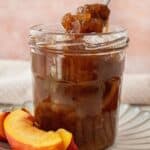
Nectarine Chutney
My homemade Nectarine Chutney is a condiment that you will use often. It is sweet, tangy and gently spiced with a depth of flavour that will enhance the foods you serve with it. When nectarines are in season, I like to enjoy them in as many ways as possible and this is one of my favourite ways to preserve this lovely fruit to enjoy in the months ahead.
Servings 4 250 ml (8 oz) jars
Calories 651kcal
Ingredients
- 1 kg (2.2 lb) nectarines - prepared weight, once stones removed See Note 1
- 500 g (2 ½ cups) light brown sugar
- 450 ml (1 ¾ cups + 2 teaspoon ) white vinegar - 5% acidity
- 2 medium brown/yellow onions - finely chopped
- 1 large Granny Smith apple - unpeeled and cut into small cubes
- 1 teaspoon ground black pepper
- 1 ½ teaspoon sea salt
- 1 teaspoon ground cinnamon
- ½ teaspoon red chilli pepper flakes
- 1 teaspoon ground ginger
- ¼ teaspoon ground nutmeg
Instructions
To Sterilise the Jars:
- Sterilise the jars you'll be using to store the chutney. Choose glass jars with an airtight, metal lid and ensure they have been washed by hand in hot soapy water then rinsed well. Check that the metal lids do not have rubber inserts – if they do, allow them to air dry, instead of placing in the oven.Preheat the oven to 130 Degrees C (270 F) and place the jars in the oven for 15-20 minutes. Keep the jars warm.
For the Nectarine Chutney:
- Cut the nectarines in half and gently twist the halves in opposite directions to separate them.Carefully remove the pit with a sharp, pointed knife and discard the pit. Cut away any bruises or blemishes from the fruit.
- Cut the nectarines into large chunks. (About 2.5 cm or 1 inch)
- Place all of the ingredients into a large, non-reactive saucepan or stockpot. See Note 2.Stir over medium-high heat until the sugar dissolves.
- Bring the chutney to boiling point then allow it to simmer for approximately 40-45 minutes.Stir occasionally until the mixture has reduced in volume, the surplus liquid has evaporated and the mixture thickens. The simmering time may vary as it will depend on the size of the pan and the amount of heat applied. As it thickens, you will need to be diligent with stirring and watch that it does not catch on the bottom of the pan. You can check that the chutney is ready by sliding a wooden spoon across the surface of the mixture. It is ready when the chutney does not immediately fill the gap. If the chutney is still too runny, cook it a further 5 minutes and test again.
- Be aware that as the liquid reduces, the mixture may bubble and spit and you need to take great care. I suggest that to be on the safe side, you wear a garment with long sleeves to protect yourself and use a long handled wooden spoon.
- After 40-45 minutes, or your chutney has thickened as per above, remove the saucepan from the heat and stand for 10 minutes to allow the fruit to settle. Remove and discard the star anise.
- Remove your sterilised jars from the oven, and whilst they are still hot, fill with the chutney and seal the jars immediately.
- When the jars are cool enough to handle, remove any spills on the outside of the jars and label and date the chutney. Store it in a cool, dark, dry location. Set it aside for a minimum of one week, ideally two-four weeks. This will allow the flavours of the chutney to amalgamate and the vinegar to mellow.When removing chutney, always use a clean, dry spoon to avoid spoilage. Store open jars in the fridge.
Notes
- Nectarines: for accuracy, we recommend weighing the fruit once you have removed the stones and any blemishes from the fruit. You can use different varieties of nectarines for this recipe - the colour may vary slightly depending on the variety.
- Non-reactive saucepans: are those which are ceramic, stainless steel, glass or enamelled cookware. Copper, iron and aluminium pans are reactive. Acidic foods, such as vinegar or lemons, may take on a metallic taste and discolour if cooked in such pans.
- Maturing the chutney: a preserve made with vinegar needs time to mature. Set it aside for a minimum of one week, ideally two-four weeks. This will allow the flavours of the chutney to amalgamate and the vinegar to mellow.
- Storage: when the recipe is made according to instructions and the jars have been sterilised properly, the chutney will be shelf-stable for nine months when stored in a cool, dark place. A jar should be refrigerated after opening. Always use a clean spoon when removing chutney from the jar. This recipe has not been tested using a canning method. Please refer to the USDA Canning Guidelines for techniques, or follow a recipe designed for long-term canning.
- Nutritional information: is based on one whole jar. The nutritional information is an estimate only.
Nutrition
Calories: 651kcal | Carbohydrates: 160g | Protein: 4g | Fat: 1g | Saturated Fat: 0.1g | Polyunsaturated Fat: 0.1g | Monounsaturated Fat: 0.03g | Sodium: 949mg | Potassium: 657mg | Fiber: 7g | Sugar: 149g | Calcium: 141mg | Iron: 2mg